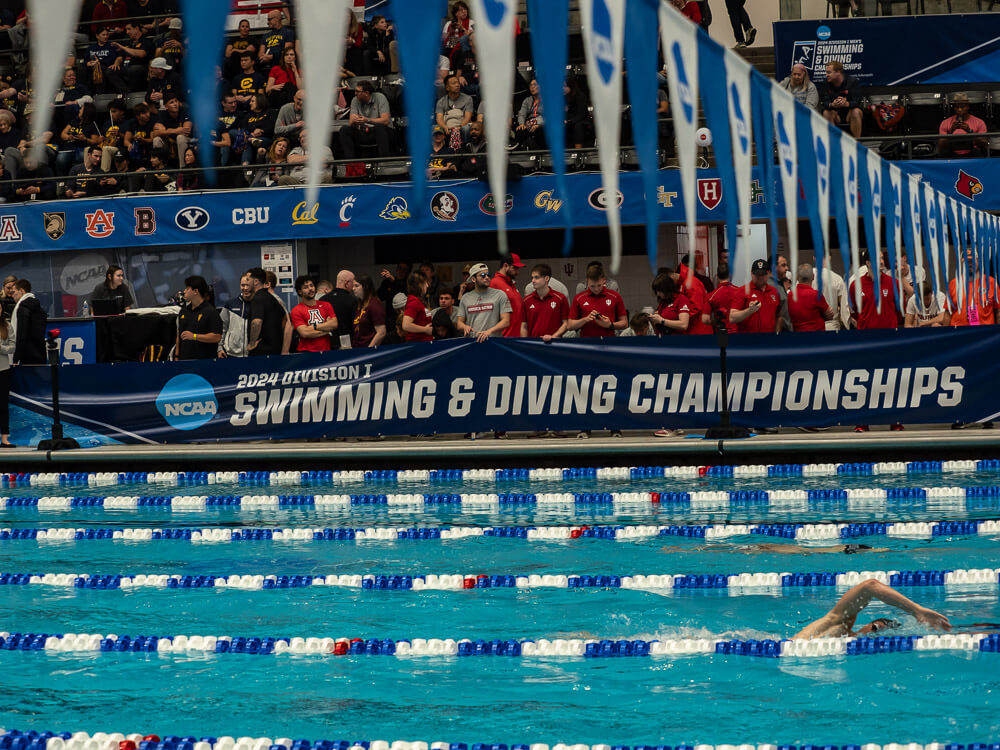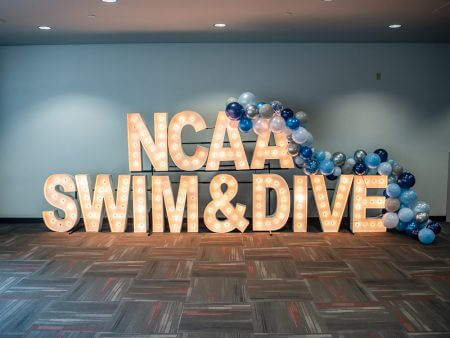How NCAA Realignment Will Eventually Boost College Swimming This Season

How NCAA Realignment Will Eventually Boost College Swimming This Season
The new era of U.S. college athletics took shape just over a year ago, rising from the ashes of a Pac-12 conference that failed to secure a television deal on par with its fellow power conferences. Within months eight universities departed the conference, with Oregon and Washington heading to the Big Ten and four schools, including Arizona and Arizona State, heading to the Big-12. Stanford and Cal were temporarily left homeless before finding refuge in the Atlantic Coast Conference, a highly ironic destination given their location on the West Coast.
Those changes plus the previously-determined relocations of Southern California and UCLA to the Big Ten and Texas and Oklahoma to the SEC set off further conference-hopping at lower levels of athletics, and the results of this money-laced game of musical chairs has been on display during the first month-and-a-half of the college football season.
The week seven slate of games included three longtime Big Ten schools making cross-country trips: Ohio State at Oregon was the week’s most anticipated matchup while Penn State visited USC and Minnesota traveled to UCLA. Meanwhile, Washington traveled east to play Iowa. One week earlier, Michigan visited Washington and Michigan State played at Oregon while USC (Minnesota) and UCLA (Penn State) each headed east. Earlier, Stanford was away from Palo Alto for more than a week while playing Syracuse and Clemson in one trip to more natural ACC territory.
Such scheduling means significant hassles for travel managers around the country and hundreds of additional airplane hours for the young people who are purportedly “student-athletes.” The logistics will be far more daunting for men’s and women’s basketball teams this winter; football teams play once per week, with a maximum of four or five conference contests on the road, but basketball teams play each conference rival at least once. Midweek trips between Pennsylvania and California are about to become the norm. The Midwest to the Pacific Northwest and back, multiple times per month.
Revenue sports drove the changes and are facing the consequences in their scheduling. For sports like swimming, however, teams find themselves in new leagues without any true differences until championship meets in February.

Photo Courtesy: Peter H. Bick
Indeed, these tradition-laden swim teams will make virtually no changes to their regular-season schedule from previous years. Stanford and Cal are still competing against each other (multiple times) plus Arizona State, USC and UCLA (for the women). None of the former Pac-12 teams are swimming dual meets against any of their new conference foes, and if that changes in future seasons, it will only be driven by coaches in search of quality midseason competition.
Texas, meanwhile, will compete against SEC rivals Georgia and Texas A&M, but those are teams the Longhorns have previously raced while existing in the swimming vacuum of the Big-12. Texas also plays host to arguably the year’s most anticipated dual meet, with Arizona State, Virginia and NC State traveling to Austin, a late January meet of four teams from three different conferences.
Midseason invitationals? Conference alignment has never mattered for those, with teams choosing a location at the discretion of the coaching staff. The Cardinal and Sun Devils have both been regular attendees at NC State’s invitational in Greensboro in recent years.
Meanwhile, realignment will deliver significantly elevated conference-championship meets in February. The days of Texas sleepwalking through the Big-12 Championships, crushing four lackluster women’s teams and just two men’s teams, are over. Instead, we will get the Longhorns against Florida, Georgia, Tennessee and Auburn.
Perhaps Arizona State will take on that role of dominating the Big-12, but fans will get to see Stanford and Cal added to the ACC Championships, a meet that has become one of the country’s premier February showcase since women and men were combined into one meet in recent seasons. There will literally be Olympic-medal rematches at the conference meet as Virginia’s Gretchen Walsh battles Stanford’s Torri Huske before their ultimate showcase on the national level. Meanwhile, the tightly-packed Big Ten (for both genders) will provide great competition for USC and the UCLA women, especially compared to the top-heavy but depth-lacking nature of the old Pac-12.
Swim teams will have to travel cross-country for these conference meets, but location hardly matters when the athletes and coaches spend nearly a week at these championship events. It becomes a big logistical undertaking and long trip whether an hour-long drive, as North Carolina and Duke will make to the ACC Championships, or the five-hour flight for Stanford and Cal.
One key caveat here: the future of college swimming is far from secure, not with direct payments from universities to athletes coming in a year or two, ensuring a strain on the finances of athletic departments large and small. It’s all but guaranteed that swimmers will lose opportunities on the next level, particularly on the men’s side.
This particular change, though, will produce an enhanced version of conference-championship season, already a highlight of the sport’s calendar, while not forcing swimmers to endure the headaches plaguing revenue sports this season.



